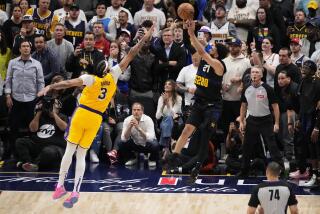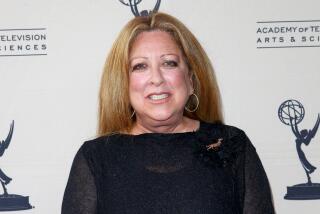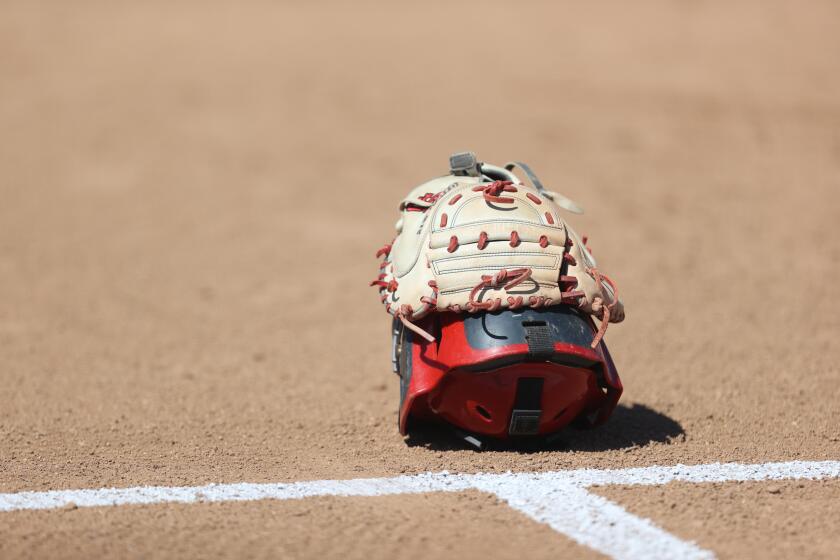Come March, Pac-10 could face a different kind of ‘one and done’
Pacific 10 Conference officials may find a whole new meaning to the phrase “one and done.” One team in the NCAA men’s basketball tournament and done by the time the first round is in the books.
It may sound like real March madness, but the unthinkable sits on the horizon as the conference’s basketball reputation sinks quickly in the West this season.
For the first time since 1987, the conference does not have a team in the top 25, a 431-week stretch that ended when Washington, billed as a flagship team, started taking on water. Conference teams, weakened by a number of underclassmen jumping to the NBA, are 1-15 against teams currently ranked in the top 25.
There appears to be little the conference can do at this point, as public opinion has already fitted the Pac-10 with an off-the-rack mid-major wardrobe.
“If the selection committee met today, evaluated the body of work, applied its criteria . . . it is very unlikely the Pac-10 would get more than one team,” said former UCLA coach Steve Lavin, now an analyst with ESPN.
“This is the dilemma a vast majority of mid-majors have dealt with for years in trying to get multiple bids,” he said. “What’s unusual about it is this is usually a power conference.”
There is a power outage at the moment for a conference that sent six teams to the tournament each of the last two seasons.
But this season, it’s unlikely that UCLA Athletic Director Dan Guerrero, the head of the committee, will have to excuse himself from the discussion when wrangling over the at-large teams begins. His conference may not be in that tug of war.
“I would certainly hope not,” Pac-10 Assistant Commissioner Dave Hirsch said when asked if the conference could have only one team in the tournament. “I think we have teams that do warrant consideration.”
But it would help, Hirsch said, “if a couple of our teams would separate themselves, but everyone is beating up on each other right now.”
The value of winning conference games has dipped in the Pac-10. The Big East Conference has six teams ranked among the top 12, offering chances for a marquee victory to impress committee members.
“The Big Ten, the Big East, the Big 12, they have teams that are considered quite strong,” Lavin said.
“Wins against them are viewed as quality wins that can get you off the bubble.”
California was ranked 13th and Washington 14th when the season began. The Golden Bears were unranked when conference play began, and the Huskies followed them out of the poll after losing three of their first four conference games.
“We didn’t have a school in the preseason top four or five; that has hurt us,” Oregon Coach Ernie Kent said. “You need that team to be perceived as having a chance to win the national title. UCLA has been that team the past three years.”
UCLA this season has had trouble on the regional level, including nonconference play, with a 1-3 record against Southern California teams. Such woes were shared throughout the conference.
Arizona was blown out at home by Brigham Young. USC lost to Loyola Marymount. Stanford was beaten by Oral Roberts. Oregon State lost to Sacramento State.
“We kind of made our bed in November and December,” Cal Coach Mike Montgomery said.
The conference’s only victory over a current top-25 team was USC’s upset over Tennessee, now ranked eighth. That means little because the Trojans have a self-imposed ban on postseason play.
The conference’s next-best spotlight moment was Stanford’s missing two free throws with seconds left in regulation and losing, 73-65, in overtime to undefeated Kentucky, then ranked No. 5.
Hirsch pointed out that Cal played Syracuse (now ranked No. 5) and Ohio State (now ranked 21st) without injured forward Theo Robinson, who is averaging 14 points a game.
Montgomery was in on that campaign, saying, “The conference is not as bad as everyone wants to make it out to be,” but he acknowledged that “once the perception comes, and is perpetuated, there is not much we can do about it.”
The perception has taken hold.
The Pac-10 is eighth in the RPI rating, behind the Atlantic 10 and Mountain West. Cal, at 24, is the highest-rated team in the index as of Friday. Arizona State, at No. 55, is the conference’s next-highest-ranked team, checking in 11 slots below Harvard.
“A lot is based on nonconference play, and we didn’t impress anybody,” Hirsch said, though he noted that a Stanford victory “would have given Kentucky its only loss.”
Since the NCAA tournament was expanded to 64 teams in 1985, the power conferences -- Atlantic Coast, Big East, Big 12, etc. -- have always received at least two team bids. The NCAA began inviting multiple conference teams in 1975 and only twice has the Pac-10 been limited to one team (in 1977 and 1978).
“I just think when you look at it historically, we’ve been very, very successful in regard to the tournament,” UCLA Coach Ben Howland said. “We’ll still end up with two or three teams.”
The Pac-10 has had at least one team reach the Sweet 16 in 20 of the last 22 seasons, with eight Final Four teams since 1994, one more than both the Big East and Big 12.
UCLA won the title in 1995 and Arizona in 1997. That’s ancient history in the eye of selection committee.
“The committee tries to emphasize only this season,” said Tom Hansen, former Pac-10 commissioner.
“But they have to understand where the best basketball has been played over the years.”
The committee, though, is supposed to have a short memory, and “a lot of people are going to look to see how that is applied now that the Pac-10 is facing the same thing mid-majors have faced,” Lavin said.
How this became the middle-of-the-Pac-10 is easily traced.
Talent has disappeared as if part of a Ponzi scheme. Only five of the 17 players chosen to the conference’s all-freshman team the last three seasons remain.
UCLA’s Kevin Love and USC’s O.J. Mayo would be juniors. Six of the 10 conference teams have had players jump early to the NBA.
“When the season started, we had 51 sophomores and freshmen on our rosters, which was more than the junior and senior classes combined,” Hirsch said.
Everyone has had to deal with the one-and-done syndrome, with top freshmen using college basketball as a momentary pause on the way to the NBA.
Hansen, Lavin and Montgomery, all with lengthy Pac-10 resumes, said they have never seen a season like this for the conference.
“It’s not just that the Pac-10 has been ravaged by underclassmen leaving,” Lavin said. “They have lost guys, seniors, who were pillars for their teams, and the returning players haven’t elevated their games. Then you look at this year’s freshman class and there are not a whole lot of bright spots. It is a perfect storm.”
One the Pac-10 has never needed shelter from in the past.
Said Lavin: “It will give them some empathy and appreciation for the frustration level the mid-majors have every year.”
twitter.com/cfosterlatimes
More to Read
Get our high school sports newsletter
Prep Rally is devoted to the SoCal high school sports experience, bringing you scores, stories and a behind-the-scenes look at what makes prep sports so popular.
You may occasionally receive promotional content from the Los Angeles Times.







